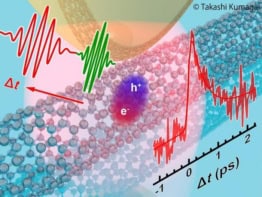
A photonic chip that allows a conventional microscope to work at nanoscale resolution has been developed by a team of physicists in Germany and Norway. The researchers claim that as well as opening up nanoscopy to many more people, the mass-producible optical chip also offers a much larger field of view than current nanoscopy techniques, which rely on complex microscopes.
Nanoscopy, which is also known as super-resolution microscopy, allows scientists to see features smaller than the diffraction limit – about half the wavelength of visible light. It can be used to produce images with resolutions as high as 20–30 nm – approximately 10 times better than a normal microscope. Such techniques have important implications for biological and medical research, with the potential to provide new insights into disease and improve medical diagnostics.
“The resolution of the standard optical microscope is basically limited by the diffraction barrier of light, which restricts the resolution to 200–300 nm for visible light,” explains Mark Schüttpelz, a physicist at Bielefeld University in Germany. “But many structures, especially biological structures like compartments of cells, are well below the diffraction limit. Here, super-resolution will open up new insights into cells, visualizing proteins ‘at work’ in the cell in order to understand structures and dynamics of cells.”
Expensive and complex
There are a number of different nanoscopy techniques that rely on fluorescent dyes to label molecules within the specimen being imaged. A special microscope illuminates and determines the position of individual fluorescent molecules with nanometre precision to build up an image. The problem with these techniques, however, is that they use expensive and complex equipment. “It is not very straightforward to acquire super-resolved images,” says Schüttpelz. “Although there are some rather expensive nanoscopes on the market, trained and experienced operators are required to obtain high-quality images with nanometer resolution.”
To tackle this, Schüttpelz and his colleagues turned current techniques on their head. Instead of using a complex microscope with a simple glass slide to hold the sample, their method uses a simple microscope for imaging combined with a complex, but mass-producible, optical chip to hold and illuminate the sample.
“Our photonic chip technology can be retrofitted to any standard microscope to convert it into an optical nanoscope,” explains Balpreet Ahluwalia, a physicist at The Arctic University of Norway, who was also involved in the research.
Etched channels
The chip is essentially a waveguide that completely removes the need for the microscope to contain a light source that excites the fluorescent molecules. It consists of five 25–500 μm-wide channels etched into a combination of materials that causes total internal reflection of light.
The chip is illuminated by two solid-state lasers that are coupled to the chip by a lens or lensed fibres. Light with two different wavelengths is tightly confined within the channels and illuminates the sample, which sits on top of the chip. A lens and camera on the microscope record the resulting fluorescent signal, and the data obtained are used to construct a high-resolution image of the sample.
To test the effectiveness of the chip, the researchers imaged liver cells. They demonstrated that a field of view of 0.5 × 0.5 mm2 can be achieved at a resolution of around 340 nm in less than half a minute. In principle, this is fast enough to capture live events in cells. For imaging times of up to 30 min, a similar field of view at a resolution better than 140 nm is possible. Resolutions of less than 50 nm are also achievable with the chip, but require higher magnification lenses, which limit the field of view to around 150 μm.
Many cells
Ahluwalia told Physics World that the advantage of using the photonic chip for nanoscopy is that it “decouples illumination and detection light paths” and the “waveguide generates illumination over large fields of view”. He adds that this has enabled the team to acquire super-resolved images over an area 100 times larger than with other techniques. This makes single images of as many as 50 living cells possible.
According to Schüttpelz, the technique represents “a paradigm shift in optical nanoscopy”. “Not only highly specialized laboratories will have access to super-resolution imaging, but many scientists all over the world can convert their standard microscope into a super-resolution microscope just by retrofitting the microscope in order to use waveguide chips,” he says. “Nanoscopy will then be available to everyone at low costs in the near future.”
The chip is described in Nature Photonics.



